Ocean – Đại dương là vùng nước mặn chiếm khoảng 71% bề mặt Trái đất.Nó gồm năm đại dương, theo thứ tự giảm dần theo diện tích, Thái Bình Dương, Đại Tây Dương, Ấn Độ Dương, Nam Cực và Bắc Cực.
Nước biển bao phủ khoảng 361.000.000 km2 (139.000.000 sq mi) và theo thông lệ được chia thành một số đại dương chính và các biển nhỏ hơn, với tổng thể đại dương bao phủ khoảng 71% bề mặt Trái đất và 90% sinh quyển của Trái đất. Đại dương thế giới chứa 97% lượng nước trên Trái đất, và các nhà hải dương học đã tuyên bố rằng ít hơn 20% đại dương đã được lập bản đồ. Tổng thể tích xấp xỉ 1,35 tỷ km khối (320 triệu cu mi) với độ sâu trung bình gần 3.700 mét (12.100 ft).
Vì đại dương của thế giới là thành phần chính của thủy quyển Trái đất, nó không thể thiếu đối với sự sống, tạo thành một phần của chu trình carbon và ảnh hưởng đến các kiểu khí hậu và thời tiết. Đại dương là nơi sinh sống của 230.000 loài đã biết, nhưng do phần lớn chưa được khám phá nên số lượng loài trong đại dương lớn hơn nhiều, có thể trên hai triệu.
Nguồn gốc của các đại dương trên Trái đất là không rõ; một lượng nước khá lớn đã có trong vật chất hình thành nên Trái đất. Các đại dương được cho là đã hình thành vào kỷ Hadean và có thể là nguyên nhân cho sự xuất hiện của sự sống. Có rất nhiều vấn đề môi trường đối với các đại dương, ví dụ như ô nhiễm biển, đánh bắt quá mức, axit hóa đại dương và các tác động khác của biến đổi khí hậu đối với đại dương.
Trẻ luôn cảm thấy hứng thú khi tìm hiểu những thứ xung quanh chúng, đặc biệt là thế giới dưới nước. Hãy cùng trẻ học một số từ vựng tiếng Anh theo chủ đề Ocean – Đại dương dưới đây nhé!
Từ vựng chủ đề Ocean – Đại dương
estuary (n): cửa sông
An area where water passes through and a river current meets the tide
→ Useful in the open ocean, elemental analysis is especially suitable in estuaries and coastal areas, for tying a fish’s early development to particular wetlands or embayments.

—
abyss (n): vực thẳm
A deep space that is not measurable, such as a gulf
→ Man had explored the poles, the continents, the peaks, space and the abysses, but the balloon, which first flew in 1783 still had to fly around the world.

—
lagoon (n): đầm nước mặn
A small, shallow body of water that is separated from the sea by coral reefs
→ Spain and France do not consider distinction between restricted or chocked lagoons.

—
mammal (n): động vật có vú
A warm-blooded vertebrate that has hair and mammary glands
→ Seimac customers range from the Royal Danish Air Force to biologists tracking ocean mammal migration patterns.

—
atoll (n): đảo san hô
A specific are that is shaped in a ring, such as a reef or an island
→ The atoll of Anaa was known by the legendary cruelty of its soldiers who in the seventeenth century, dominated the north-west of the Tuamotus.

—
photosynthesis (n): sự quang hợp
The method in which green plants and other organisms use sunlight to process nourishment from water and carbon dioxide
→ However, some organisms can use it as a source of energy in photosynthesis.

—
plankton (n): sinh vật phù du
Organisms that occur in an area of water usually made up of small amounts of algae and protozoa
→ In freshwater, coho feed on aquatic and aerial insects, plankton and occasionally small fish.

—
submersible (n): tàu ngầm
A small water craft or boat used for exploring
→ Arcuate-winged submersible vehicles having improved hydrodynamic stability and maneuverability for use in, for example, underwater payload delivery and data acquisition.

—
tide (n): thủy triều
The rise and fall of the waters of the ocean that is a direct result of the connection between the moon and sun
→ Along the coast, storm surge in Louisiana generally ran 4 to 5 feet (1.2 to 1.5 m) above normal, although a slightly higher tide was reported near Intracoastal City.

—
coral (n): san hô
A sedentary substance made up of marine life exoskeletons, often creating large reefs
→ So for all of these reasons, all of these ecosystem services, economists estimate the value of the world’s coral reefs in the hundreds of billions of dollars per year.

—
crustacean (n): động vật giáp xác
Arthropods found in water that often have a hard shell or crust that covers its body such as a lobster or crab
→ They are a group of small crustaceans found in ocean and freshwater habitats.




